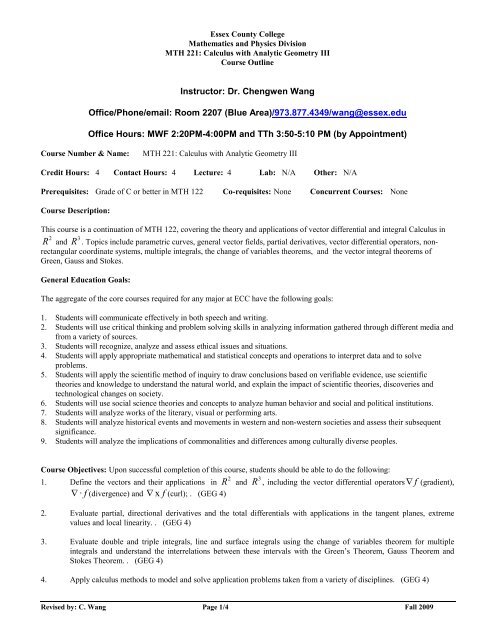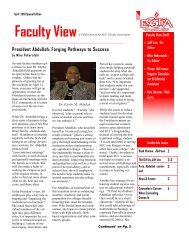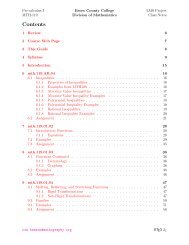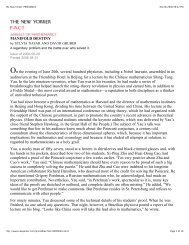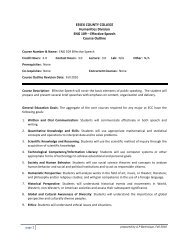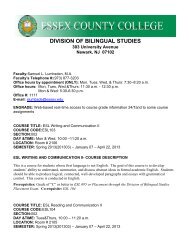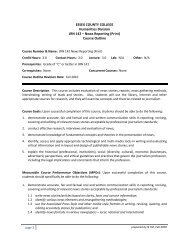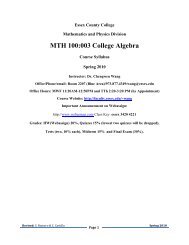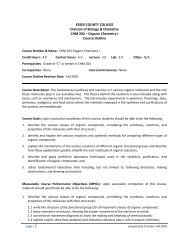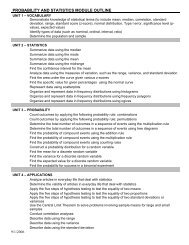Instructor: Dr. Chengwen Wang Office/Phone/email: Room 2207 ...
Instructor: Dr. Chengwen Wang Office/Phone/email: Room 2207 ...
Instructor: Dr. Chengwen Wang Office/Phone/email: Room 2207 ...
Create successful ePaper yourself
Turn your PDF publications into a flip-book with our unique Google optimized e-Paper software.
Essex County College<br />
Mathematics and Physics Division<br />
MTH 221: Calculus with Analytic Geometry III<br />
Course Outline<br />
<strong>Instructor</strong>: <strong>Dr</strong>. <strong>Chengwen</strong> <strong>Wang</strong><br />
<strong>Office</strong>/<strong>Phone</strong>/<strong>email</strong>: <strong>Room</strong> <strong>2207</strong> (Blue Area)/973.877.4349/wang@essex.edu<br />
<strong>Office</strong> Hours: MWF 2:20PM-4:00PM and TTh 3:50-5:10 PM (by Appointment)<br />
Course Number & Name:<br />
MTH 221: Calculus with Analytic Geometry III<br />
Credit Hours: 4 Contact Hours: 4 Lecture: 4 Lab: N/A Other: N/A<br />
Prerequisites: Grade of C or better in MTH 122 Co-requisites: None Concurrent Courses: None<br />
Course Description:<br />
This course is a continuation of MTH 122, covering the theory and applications of vector differential and integral Calculus in<br />
2 3<br />
R and R . Topics include parametric curves, general vector fields, partial derivatives, vector differential operators, nonrectangular<br />
coordinate systems, multiple integrals, the change of variables theorems, and the vector integral theorems of<br />
Green, Gauss and Stokes.<br />
General Education Goals:<br />
The aggregate of the core courses required for any major at ECC have the following goals:<br />
1. Students will communicate effectively in both speech and writing.<br />
2. Students will use critical thinking and problem solving skills in analyzing information gathered through different media and<br />
from a variety of sources.<br />
3. Students will recognize, analyze and assess ethical issues and situations.<br />
4. Students will apply appropriate mathematical and statistical concepts and operations to interpret data and to solve<br />
problems.<br />
5. Students will apply the scientific method of inquiry to draw conclusions based on verifiable evidence, use scientific<br />
theories and knowledge to understand the natural world, and explain the impact of scientific theories, discoveries and<br />
technological changes on society.<br />
6. Students will use social science theories and concepts to analyze human behavior and social and political institutions.<br />
7. Students will analyze works of the literary, visual or performing arts.<br />
8. Students will analyze historical events and movements in western and non-western societies and assess their subsequent<br />
significance.<br />
9. Students will analyze the implications of commonalities and differences among culturally diverse peoples.<br />
Course Objectives: Upon successful completion of this course, students should be able to do the following:<br />
2 3<br />
1. Define the vectors and their applications in R and R , including the vector differential operators ∇ f (gradient),<br />
∇ · f (divergence) and ∇ x f (curl); . (GEG 4)<br />
2. Evaluate partial, directional derivatives and the total differentials with applications in the tangent planes, extreme<br />
values and local linearity. . (GEG 4)<br />
3. Evaluate double and triple integrals, line and surface integrals using the change of variables theorem for multiple<br />
integrals and understand the interrelations between these intervals with the Green’s Theorem, Gauss Theorem and<br />
Stokes Theorem. . (GEG 4)<br />
4. Apply calculus methods to model and solve application problems taken from a variety of disciplines. (GEG 4)<br />
Revised by: C. <strong>Wang</strong> Page 1/4 Fall 2009
5. Use a scientific and/or graphing calculator or other suitable mathematical software effectively as a tool to solve such<br />
problems as those described above. (GEG 4)<br />
6. Express in written and/or oral form appropriate mathematical terminology and notation (GEG 1)<br />
Outcomes Assessment:<br />
All test and exam questions are blueprinted to course objectives. Data is collected and analyzed to determine the level of<br />
student performance on these assessment instruments in regards to meeting course objectives. The results of this data analysis<br />
are used to guide necessary pedagogical and/or curricular revisions.<br />
Methods of Instruction:<br />
Instruction will consist of a combination of lectures, presentation of sample problems, clarification of homework<br />
exercises/textbook material, and general class discussion.<br />
Course Requirements:<br />
1. Regular attendance; excessive absences will negatively affect student understanding and performance.<br />
2. Completing reading and problem solving homework in a timely manner and contribute to class discussions. Mathematics<br />
cannot be understood without doing a significant amount of outside study.<br />
3. Participation in a peer study group that meets regularly and maintains effective member communication links.<br />
4. Taking tests and exams when scheduled. No make-ups will be permitted. The first missed test will be recorded as a zero<br />
until the end of the semester, at which time the final exam grade will also be used to replace the missing test grade.<br />
Grades from any other missed tests will be recorded as irreplaceable zeros. The Comprehensive Final Exam is<br />
required and cannot be rescheduled unless some extraordinary event occurs and prior arrangement is made with the<br />
instructor.<br />
Method of Evaluation:<br />
Final Averages will be computed as follows:<br />
• 3 Tests (dates specified by the instructor with at least one week advanced notice) 60 % of the Final Avg<br />
Tests will show evidence of the extent to which students meet course objectives,<br />
including, but not limited to, identifying and applying concepts, analyzing and<br />
solving problems, estimating and interpreting results, and stating appropriate<br />
conclusions using correct terminology.<br />
• Optional Assignments/Webassign Class key: essex 9061 9622 15% of the Final Avg<br />
e.g., Problems Sets, Research Projects, etc., designed to enhance understanding<br />
of the applications of calculus in engineering.<br />
• Final Exam 25% of the Final Avg<br />
The comprehensive final exam will examine the extent to which students have<br />
understood and synthesized all course content and achieved all course<br />
objectives.<br />
Students may use a scientific or graphing calculator or laptop computer to enhance understanding during class or<br />
while doing homework. However, no form of technological aid can be used on tests/exams.<br />
Final Grade Ranges are:<br />
[A 90 – 100] [B+ 85 – 89] [B 80 – 84] [C+ 75 – 79] [C 70 – 74] [D 60 – 69] [F 00 – 49]<br />
Course Content Outline: Based on the text Calculus: Early Transcendentals 6 th Edition<br />
Stewart, 0-53878256-0, Cengage/Brooks/Cole<br />
Revised by: C. <strong>Wang</strong> Page 2/4 Fall 2009
Class Meeting<br />
Chapter/<br />
Section Topic<br />
Chapter 10: Parametric Equations and Polar Coordinates<br />
1 10.1 Curves Defined by Parametric Equations<br />
10.2 Calculus with Parametric Curves<br />
2 10.3 Polar Coordinates<br />
10.4 Areas and Lengths in Polar Coordinates<br />
3 10.5 Conic Sections<br />
10.6 Conic Sections in Polar Coordinates<br />
Chapter 12: Vectors and Geometry of Space<br />
4 12.1 Three-Dimensional Coordinate Systems<br />
12.2 Vectors and Geometry of Space<br />
5 12.3 The Dot Product<br />
12.4 The Cross Product<br />
6 12.5 Equations of Lines and Planes<br />
12.6 Cylindrical and Spherical Coordinates<br />
Chapter 13: Vector Functions<br />
7 13.1 Vector Functions and Space Curves<br />
13.2 Derivatives and Integrals of Vector Functions<br />
8 13.3 Arc Length and Curvature<br />
13.4 Velocity and Acceleration<br />
9 Test 1<br />
Chapter 14: Partial Derivatives<br />
10 14.1 Functions of Several Variables<br />
14.2 Limits and Continuity<br />
14.3 Partial Derivatives<br />
11 14.4 Tangent Planes, Linear Approximation and Differentials<br />
12 14.5 The Chain Rule<br />
13 14.6 The Gradient Vector and Directional Derivatives<br />
14 14.7 Extrema of Functions of Several Variables<br />
14.8 Constrained Optimization and Lagrange Multipliers<br />
15 Test 2<br />
Chapter 15: Multiple Integrals<br />
16 15.1 Double Integrals over Rectangles<br />
15.2 Iterated Integrals<br />
15.3 Double Integrals over General Regions<br />
17 15.4 Double Integrals in Polar Coordinates<br />
15.5 Applications of Double Integrals - Surface Area<br />
18 15.6 Triple Integrals<br />
15.7 Triple Integrals in Cylindrical Coordinates<br />
15.8 Triple Integrals in Spherical Coordinates<br />
19 15.9 Change of Variables in Multiple Integrals<br />
Chapter 16: Vector Calculus<br />
20 16.1 Vector Fields<br />
21 16.2 Line Integrals<br />
22 16.3 Independence of Path and Conservative Vector Fields<br />
(The Fundamental Theorem for Line Integrals)<br />
23 Test 3<br />
Revised by: C. <strong>Wang</strong> Page 3/4 Fall 2009
Class Meeting<br />
Chapter/<br />
Section Topic<br />
24 16.4 Green’s Theorem<br />
25 16.5 Curl and Divergence<br />
16.6 Parametric Surfaces and Their Areas<br />
26 16.7 Surface Integrals<br />
27-28 16.8 Stokes’ Theorem<br />
16.9 The Divergence Theorem<br />
29 Final Exam<br />
Revised by: C. <strong>Wang</strong> Page 4/4 Fall 2009


